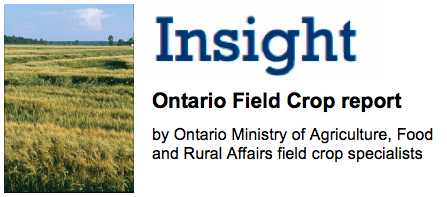Canola/Edible Beans: Brian Hall
Canola: Early planted canola is at 1-2 leaf and later April planted canola is cotyledon to 1 leaf stage. Heavy rains in several areas resulted in crusting and emergence issues. Flea beetle pressure is high in some areas. Populations are highest in field borders. Scout emerged canola for flea beetles up to 4 leaf stage. Threshold for control is 25% leaf feeding. Timing for flea beetle control may precede weed control. Critical weed control period is 1-4 leaf stage but schedule weed control at early stages. Take time to clean spray tanks thoroughly before applying post-emergent herbicide, canola is quite sensitive to many products.
Edible Beans: Seeding rate for white or black beans in 15 inch rows is 150,000 seeds/ac (3 – 4 seeds/foot of row), 110,000 seeds/ac in 21 inch rows (3.5 - 4.5 seeds/ft) and 90,000 seeds/ac (4.5 - 5 seeds/ft) in 30 inch rows. Dry beans require significant moisture to germinate. Plant into excellent soils conditions, at a uniform depth of 1.5 - 2.5 inches and 1.25cm (½”) into moist soil.
Cereals: Peter Johnson/Scott Banks
Winter cereals are far ahead of normal development. Rye and barley are in full head, advanced wheat fields are at head emergence. Combines need to be ready to harvest two weeks earlier than ever before. Dry weather and low fusarium risk has some growers questioning the need for fusarium control. Remember that the fusarium fungicides Caramba and Prosaro give foliar leaf disease control and improve straw yields and quality, along with reduced fusarium and DON concentrations in the grain. Leaf disease pressure remains low with some powdery mildew pressure. Aphid populations are building in wheat fields along the Lake Erie shoreline. Scout!
Spring cereals continue to progress with early fields at first node (GS 31). Many producers are waiting to apply herbicides to get more value from the fungicide application. Early fungicides have little yield impact in spring cereals. If weed pressure is significant, or grass weeds are an issue, this decision may cost growers in lost yield potential.
Corn: Greg Stewart
Corn planting is 95 % complete across the province. Emergence is good to excellent in most areas with the majority of the corn in the 1-3 leaf stage. Weed control should be the priority as the crop approaches the critical 3-4 leaf stage. Cutworm injury has been reported in some areas south of London. Scout fields that had significant weed growth before planting. Guidelines for post-emerge UAN application: 1) UAN (fan nozzle) and herbicide - max. 2 leaf corn, 2) UAN (fan nozzle) no herbicide - max. 3 leaf corn, 3) UAN (streamer nozzle) - max. 6 leaf corn. Loss of N through volatilization will be greater if surface applied UAN does not receive rainfall to incorporate into the soil. Possible strategies are: 1) delay application until rainfall is more likely, 2) apply additional N (15%) to compensate for losses, 3) add a urease inhibitor (i.e. Agrotain) to reduce volatilization losses or 4) switch application strategies to sidedress injection.
Forages/Pastures: Joel Bagg/Jack Kyle
Forages: Forage yield expectations are variable, but well below normal in many areas. Alfalfa fields severely damage by winterkill and disease are being harvested early and planted into corn for silage. Information on nitrogen credits available from legume crops is available at http://bit.ly/omafraNAdjustments. Alfalfa weevil larvae have been detected in the south-west. Feeding damage starts as leaf pinholes, progresses to feeding between the leaf veins and results in a skeletonized appearance. More information is available at http://bit.ly/omafraAlfalfaWeevil. Maturity of alfalfa is extremely variable due to frost damage and poor growth. Many forage plants are showing more advanced maturity then would be expected for plant size. Dairy producers generally target harvesting first-cut alfalfa haylage at an optimum 40% NDF. “Scissors-cut” field sampling and rapid laboratory analysis can help predict optimal harvest dates, http://bit.ly/omafraForageQuality.
Pastures: The warmer temperatures this week have made for faster grass growth. Using a quick rotation to graze all paddocks before the grass becomes mature is important. In a rotational system look to the last paddock in the rotation and adjust the rotation speed to arrive at the last paddock when it is at the right stage of growth. Applying 40 kg/ha of nitrogen after the first or second rotation will stimulate growth. If additional feed will be needed, consider seeding an annual crop for grazing, http://bit.ly/omafraAnnualForages.
Soybeans: Horst Bohner
Fifty to sixty per cent of the crop is now seeded. Some producers are finished. Very early planted beans have emerged. Under cool conditions it can take 30 days for beans to emerge. In warm temperatures beans can emerge in 4 to 7 days. Crusting has been a problem in a few areas, but not a significant problem so far. If fields were not rolled right after seeding, make sure to check how much growth there is on the seedling before rolling. Beans should not be rolled during the hook stage of emergence. If the beans are close to emergence wait for the unifoliate stage before rolling.
| Attachment | Size |
|---|---|
| 142.54 KB |



